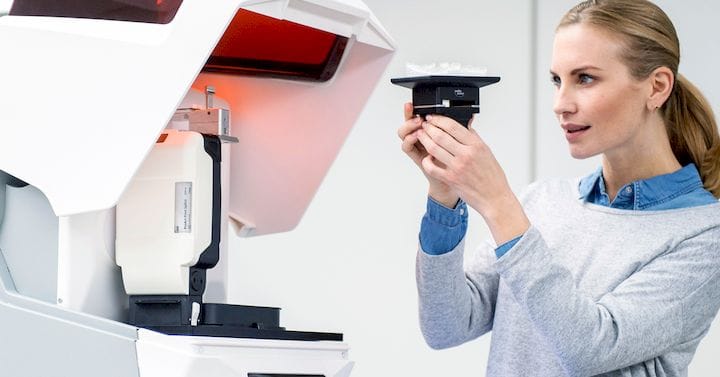![Ivoclar Vivadent’s integrated dental solution could foreshadow the future of 3D printing [Source: Ivoclar Vivadent]](https://fabbaloo.com/wp-content/uploads/2020/05/progaprint_result_img_5eb09b0cc4c76.jpg)
I’m reading about a new 3D printing system specifically designed for used in dental operations.
The machine is called the ProgaPrint, from Ivoclar Vivadent. They explain how it works:
“PrograPrint is a new 3D printing system for use in dental technology. It is integrated into a validated workflow and comprises materials and equipment for printing, cleaning and post-curing. The printing system is a new addition to Ivoclar Digital’s portfolio and complements the PrograMill milling equipment excellently.”
The device is clearly a 3D printer, as it uses the familiar SLA 3D printing process. The company offers three cartridge-based materials for use in the system including a wax material for producing casts, a plaster like material, and a specialized material for drilling templates and oclusal splints.
The idea here is that the Ivoclar Digital products are to be viewed as a single system, in which the 3D printer is merely one part. The system is highly optimized for use in dental laboratories to produce a wide variety of dental applications. It’s an end-to-end solution that includes hardware, software, materials, and process.
For dental laboratories, this could be an incredibly useful solution. Lab technicians, who are not necessarily 3D printing experts, would need only to purchase the entire system and leverage Ivoclar Digital’s integration of Machine and process. It could be a one-button purchase solution.
Further, it seems that the Ivoclar Digital products are to be shown to the public not at major 3D printing events, but rather at dental technology trade shows. This allows Ivoclar Vivadent to very specifically interact with their target audience and no one else.
From a business point of view, Ivoclar Vivadent’s strategy seems quite sensible. But there’s something interesting about this approach that may affect how 3D printing is viewed in industry.
Here we see the 3D printing component buried within a system. This is quite different from past years where the 3D printing aspect was front and center, perhaps in an attempt to gain some buzz about a new technology. That’s not the case here, where 3D printing is merely one part of many in an integrated system that provides a solution to a particular problem space.
All 3D printers ultimately are serving a purpose. That purpose is an application beyond the 3D printing technology itself. It’s to provide some benefit to a business or individual.
We know that very few products are made solely through 3D printing; in virtually all cases additional making steps must be applied. These could include post-processing, painting, drilling, assembly, casting, milling, etc. Thus one could reasonably expect to find 3D printers embedded in a larger process to produce some beneficial outcome.
That concept is exemplified by the Ivoclar Digital system.
I’m wondering if this is a brief glimpse into the future of 3D printing? Could 3D printers as standalone entities gradually disappear, folded into larger integrated systems that are providing specific types of output?
That’s certainly not the case today, but I expect this phenomenon to be more frequently seen incoming years.
Via Ivoclar Vivadent











No one seems to offer collaborative 3D printing modes on dual extrusion devices. We explain why this is the case.